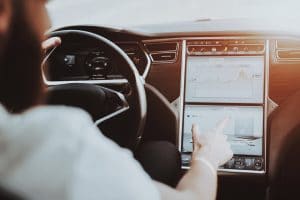The NHTSA Is Formally Investigating Tesla’s Autopilot System
 The Associated Press announced on August 16, 2021 that the National Highway Traffic Safety Administration (NHTSA) has begun an investigation into Tesla’s Autopilot partially automated driving system. The investigation was deemed necessary after several accidents with parked emergency vehicles. The NHTSA investigation will examine 765,000 vehicles – nearly all the cars Tesla has sold with the autopilot system since 2014.
The Associated Press announced on August 16, 2021 that the National Highway Traffic Safety Administration (NHTSA) has begun an investigation into Tesla’s Autopilot partially automated driving system. The investigation was deemed necessary after several accidents with parked emergency vehicles. The NHTSA investigation will examine 765,000 vehicles – nearly all the cars Tesla has sold with the autopilot system since 2014.
According to NPR, the investigation is the result of one person dying and 17 injuries in 11 crashes. The crashes all involved Tesla on Autopilot or Tesla on Traffic Aware Cruise Control systems. The federal investigation is a sign that the current administration will be monitoring automated vehicle safety more closely than the prior administration. The NHTSA had previously expressed concerns that strict oversight might hamper the “adoption of the potentially life-saving systems.”
The NHTSA investigation will focus on Tesla’s current models, including “models Y, X, S and 3 from the 2014 through 2021 model years.”
The National Transportation Safety Board (NTSB) recommends that NHTSA and Tesla confine the use of vehicles with Autopilot to safe areas, and that the NHTSA require that Tesla take steps to ensure drivers are paying attention – that they are not over-relying on the Autopilot system. So far, they NHTSA has not taken up any of the NTSB’s suggestions. The NTSB can only make recommendations. It has no enforcement powers.
The NTSB has already blamed Tesla and several drivers for failing to make sure auto manufacturers create safeguards to limit the “use of electronic driving systems.” One crash the NTSB investigated involved a Florida accident that killed the 50-year-old driver of a Tesla Model 3. The vehicle was using Autopilot. Neither the Autopilot system nor the driver “braked or tried to avoid a tractor-trailer crossing in its path.”
Part of the problem with Tesla’s Autopilot feature is that many Tesla drivers have been abusing it. Several have been caught driving while intoxicated. One Tesla driver was even photographed riding in the back seat as the vehicle traveled down a highway.
Driver-assist systems
The aim of driver automation systems is to keep the vehicle centered in its lane and not too close to vehicles in front of it. Tesla and other driver automated manufacturers claim that drivers are warned that they should be ready to intervene if needed. Since June 2016, the NHTSA has investigated 31 crashes involving these automated systems, including 25 that involved Tesla’s Autopilot. The agency said 10 deaths were reported in these crashes.
According to an electrical and computer engineer professor at Carnegie Mellon University (CMU), NHTSA should have started its probe much earlier. The CMU professor states that the probe’s top priority should be on the failure of Tesla to properly monitor its drivers to make sure they are paying attention. For example, drivers should not be able to trick the Autopilot or driver automated system. Even though Autopilot can detect pressure on the steering wheel, drivers have found ways to create that pressure without human hands.
NHTSA’s prior investigations include:
- A 2018 crash where a Tesla with an Autopilot feature struck a parked firetruck where the firetruck was partially in the travel lane with the lights flashing.
- Other crashes in California, Connecticut, Indiana, Massachusetts, Arizona, North Carolina, Michigan, Florida, and Montgomery County, Texas.
How does Tesla’s Autopilot feature work?
Tesla’s auto assist system uses camera-based systems, strong computer power, and, with some models, radar that spots obstacles. According to the CMU professor, Tesla’s radar “was plagued by “false positive” signals and would stop cars after determining overpasses were obstacles.”
Tesla now uses cameras and thousands of computer images (through a neural network) instead of the radar to spot obstacles. Tesla claims the new systems works on most objects, but had difficulty with perpendicular trucks and parked emergency vehicles in its path.
The CMU Professor states more work is required. The neural network needs more inputs to recognize more objects. The professor states that these new inputs (computer training for the driver-assist system) will “never be good enough.”
What are the goals of the NHTSA investigation into Autopilot failures?
The NHTSA says its investigation will:
- Study the “technologies and methods used to monitor, assist and enforce the driver’s engagement with the dynamic driving task during Autopilot operation.”
- “Cover object and event detection by the system, as well as where it is allowed to operate.”
- Determine factors that led to the prior Autopilot crashes.
The agency states that drivers should understand that no commercial vehicles have the capacity to drive themselves. Drivers need to know that every vehicle requires a human driver who is in control of the vehicle at all times. States like Texas will hold drivers responsible if an accident occurs, in addition to other defendants such as the car manufacturers.
The NHTSA also says it will act to protect the public and use its enforcement powers if it finds any evidence “of noncompliance or an unreasonable risk to safety.” Since June 2021, the NHTSA has ordered that all carmakers report any crash involving a fully autonomous vehicle or a partially automated driver-assist system.
Product liability lawsuits in Austin
Any driver who is injured in a car, truck, or other motor vehicle accident has the right to hold the manufacturers, distributors, and sellers of defective vehicle parts liable if a product defect causes an accident. Autopilot systems, driver assist systems, and any type of computer system are “products.” It is no excuse that the software works well “most of the time.” If the hardware/software fails to work even once, anyone who is injured can file a product liability claim.
At Slack Davis Sanger, our Austin defective auto parts lawyers work with product safety professionals to show when and why auto parts such as driver automated systems are defective. We work with experts to show just how devastating and life-changing your injuries are. We demand compensation for all your economic and non-economic losses, including your pain and suffering. To schedule an appointment with a skilled Austin personal injury lawyer, please call 800.455.8686 or fill out our contact form. Also serving clients in Dallas, Fort Worth, and throughout Texas.

The firm handles cases involving catastrophic personal injuries and deaths. Our work spans three decades of handling airplane and helicopter crashes, truck and car accidents, oilfield and construction accidents, and other devastating accidents. We try lawsuits throughout the country in both federal and state courts and have recovered hundreds of millions of dollars for our clients. To date, we have handled or tried cases in 47 states, read more about our attorneys and firm.
